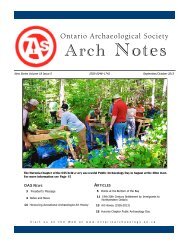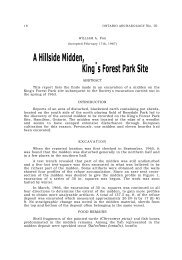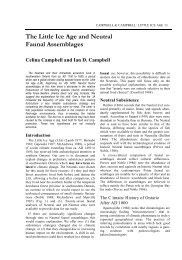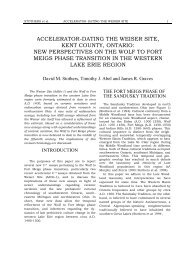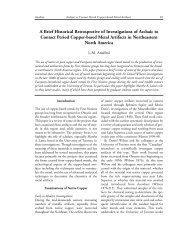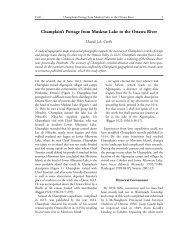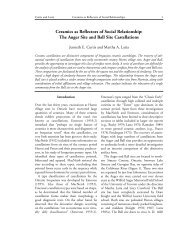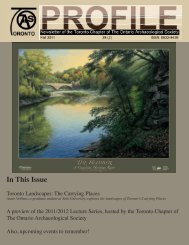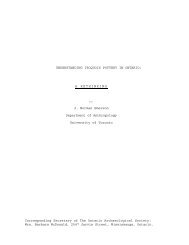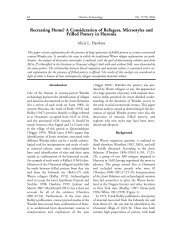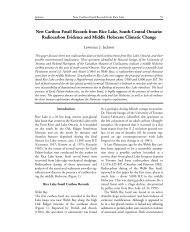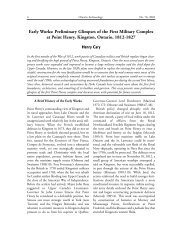Huron-St. Lawrence Iroquois Relations in the Terminal Prehistoric ...
Huron-St. Lawrence Iroquois Relations in the Terminal Prehistoric ...
Huron-St. Lawrence Iroquois Relations in the Terminal Prehistoric ...
Create successful ePaper yourself
Turn your PDF publications into a flip-book with our unique Google optimized e-Paper software.
PENDERGAST: HURON-ST. LAWRENCE RELATIONS 25Creek (1898:399) and an 8-ounce iron ball wasfound near <strong>the</strong> <strong>Iroquois</strong> site at Burville (1898:327).Harr<strong>in</strong>gton (1922:333) raises <strong>the</strong> possibility of<strong>the</strong>re be<strong>in</strong>g European material <strong>in</strong> an <strong>Iroquois</strong> contexton <strong>the</strong> Durfee site but upon reflection he rejectsthat association. Robert Weber (1968:37-38)<strong>in</strong>dicates a kaol<strong>in</strong> pipe stem and an iron axe wereseen <strong>in</strong> a collection of <strong>St</strong>. <strong>Lawrence</strong> <strong>Iroquois</strong> artifacts,all of which were alleged to be from <strong>the</strong> samelocation <strong>in</strong> <strong>the</strong> Sandy Creek area.Never<strong>the</strong>less, Marian White with full access to<strong>the</strong> literature and to <strong>the</strong> extant collections, and with<strong>the</strong> benefit of recent scientific excavations byBurger and Pratt, Miller, Waters and Weber, <strong>in</strong>addition to her own experience on some twentyvillage sites on Sandy Creek, concluded: "None of<strong>the</strong>se sites conta<strong>in</strong> European trade material..."(n.d.b:10). As Beauchamp had noted earlier(1886:107), <strong>in</strong>tensive French and English activity<strong>in</strong> this region and <strong>the</strong> proximity of <strong>the</strong>ir forts andbattles, account for <strong>the</strong> presence of <strong>the</strong> Europeanmaterial found to date <strong>in</strong> Jefferson County.Connect<strong>in</strong>g L<strong>in</strong>ksPrior to 1853 W.E. Guest, a resident ofOgdensburg, New York, visited Jefferson Countyto see at first hand <strong>the</strong> archaeological sites describedby Squire. That same year he crossed <strong>the</strong> <strong>St</strong>.<strong>Lawrence</strong> River to visit <strong>the</strong> sites we know today as<strong>the</strong> <strong>St</strong>. <strong>Lawrence</strong> <strong>Iroquois</strong> village sites at Roebuckand 27/VII or possibly <strong>the</strong> Cleary site. Although hedid not comment specifically on <strong>the</strong> similaritybetween <strong>the</strong> artifacts he excavated on <strong>the</strong>se sitesnorth of Prescott and those <strong>in</strong> Jefferson County, histext and illustrations make that connection clear(Guest 1856:271).In 1853 Hough published his History of <strong>St</strong>.<strong>Lawrence</strong> and Frankl<strong>in</strong> Counties, New York <strong>in</strong>which he noted <strong>the</strong> presence of earthworks <strong>in</strong>eastern Ontario <strong>in</strong> <strong>the</strong> townships of Augusta,Williamsburg and Osnabruck which resembledthose <strong>in</strong> <strong>St</strong>. <strong>Lawrence</strong> and Frankl<strong>in</strong> counties, and byextrapolation those <strong>in</strong> Jefferson County. He toodescribed <strong>the</strong> Roebuck site and ei<strong>the</strong>r 27/VII or <strong>the</strong>Cleary site nearby. His reference to <strong>the</strong> earthworksat Williamsburg, <strong>the</strong> Beckstead site, predate <strong>the</strong>earliest record of this site <strong>in</strong> Canadian literature byeight years and that <strong>in</strong> Osnabruck at Aultsville byover n<strong>in</strong>ety years.Sir John William Dawson published <strong>the</strong> first accountof <strong>the</strong> <strong>Iroquois</strong> artifacts be<strong>in</strong>g unear<strong>the</strong>d <strong>in</strong>downtown Montreal <strong>in</strong> 1860. These were believedto be <strong>the</strong> remnants of Cartier's Hochelaga (Dawson1860:430-449). In a second paper published <strong>in</strong>1861 Dawson became <strong>the</strong> first to remark on <strong>the</strong>similarity of this material and that recovered byGuest at Roebuck (1861:362-373). By associationhe was also <strong>the</strong> first to connect <strong>the</strong> Montrealmaterial with that <strong>in</strong> Jefferson County. In 1891Laidlaw (1891:76-77) and Boyle (1891:24) remarkedupon <strong>the</strong> similarity of certa<strong>in</strong> ceramicspecimens recovered on some <strong>Huron</strong> sites <strong>in</strong> VictoriaCounty, Ontario, and those Dawson hadrecovered <strong>in</strong> Montreal. Their speculations pioneered<strong>the</strong> th<strong>in</strong>k<strong>in</strong>g which associates <strong>the</strong>se ceramicsimilarities with <strong>the</strong> disappearance of <strong>the</strong>Hochelagans and <strong>the</strong> movement of <strong>the</strong>ir survivors to<strong>the</strong> Trent River valley <strong>in</strong> Victoria County. In 1936W<strong>in</strong>temberg described <strong>the</strong> Roebuck site <strong>in</strong> detailremark<strong>in</strong>g on how <strong>the</strong> pottery resembled that fromMontreal, Victoria County and Jefferson County(W<strong>in</strong>temberg 1936:121) <strong>the</strong>reby confirm<strong>in</strong>g, <strong>in</strong> part,<strong>the</strong> connections Guest had implied eighty yearsearlier. In 1946 W<strong>in</strong>temberg excavated Roebuck-Hochelaga-like pottery on <strong>the</strong> protohistoric Sidey-Mackay Petun site near Coll<strong>in</strong>gwood withoutmention<strong>in</strong>g <strong>the</strong> Jefferson County resemblence(W<strong>in</strong>temberg 1946:P1.20C4, C9-I4 and El).Possibly this was <strong>in</strong>ferred through <strong>the</strong> Roebuckconnection he observed.Over <strong>the</strong> period 1947-1956 Norman Emerson excavatedRoebuck-like pottery on a number of lateprehistoric <strong>Huron</strong> sites located on <strong>the</strong> Humber Rivernorth of Toronto; <strong>the</strong> Parsons, Black Creek andMcKenzie (Woodbridge) sites (Emerson 1954:1968:42). He also recovered it on <strong>the</strong> protohistoricBenson site located on <strong>the</strong> Trent River axis <strong>in</strong>Victoria County (1954:218) where it was also excavatedby Ramsden (1977). Commenc<strong>in</strong>g <strong>in</strong> 1949Pendergast excavated this dist<strong>in</strong>ctive pottery on <strong>the</strong>Payne site (1963:11) and Waupoos site (1964:76) <strong>in</strong>Pr<strong>in</strong>ce Edward County and on <strong>the</strong> Lite site(1972a:40, P1.2) on <strong>the</strong> Trent River axis <strong>in</strong> Hast<strong>in</strong>gsCounty. W<strong>in</strong>temberg earlier (1936:14) hadassociated <strong>the</strong> latter two sites with Roebuck. In1973 Burger and Pratt (1973:14) reported <strong>the</strong>dist<strong>in</strong>ctive Roebuck-like pottery on <strong>the</strong> protohistoricTrent site <strong>in</strong> Victoria County, and Nasmith (1981)reports it from <strong>the</strong> Kirche site, ano<strong>the</strong>r lateprehistoric site on <strong>the</strong> Trent River axis. Lattarecovered it on <strong>the</strong> protohistoric and historicCharlebois, Cedar Po<strong>in</strong>t and Robitaille <strong>Huron</strong> sites<strong>in</strong> <strong>Huron</strong>ia (Latta 1976:360, 392, 427). F<strong>in</strong>layson(1985) excavated over 2000 Roebuck-like rimsherdson <strong>the</strong> Draper site, a late prehistoric <strong>Huron</strong>site <strong>in</strong> Durham Regional Municipality (Pearce 1978;Pendergast n.d.). Here too as at <strong>the</strong> o<strong>the</strong>r <strong>Huron</strong>sites mentioned, this ware was a m<strong>in</strong>ority categorynot exceed<strong>in</strong>g ten percent of <strong>the</strong> pottery sample.Over <strong>the</strong> years, <strong>the</strong> <strong>Iroquois</strong> <strong>in</strong> Jefferson Countyand those on <strong>the</strong> <strong>St</strong>. <strong>Lawrence</strong> River have beenidentified as various Five Nation <strong>Iroquois</strong> tribes.Beauchamp (1894:61-69) considered <strong>the</strong>m to beOnondaga. W<strong>in</strong>temberg (1936:121) suggested <strong>the</strong>



